 Digital Voicing Equalizer DG-28 Digital Voicing Equalizer DG-28
|
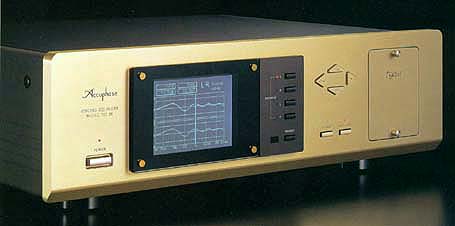
|
|
 Voicing equalizer with fully digital signal processing Voicing equalizer with fully digital signal processing |
 64 filter cells connected in parallel 64 filter cells connected in parallel |
 High-precision adjustment in 64 frequency bands, using 1/6-octave spacing High-precision adjustment in 64 frequency bands, using 1/6-octave spacing |
 Large display panel shows graphical frequency response curve Large display panel shows graphical frequency response curve |
 Built-in analyzer and sound field compensation functions Built-in analyzer and sound field compensation functions |
 Automatic measurement and adjustment Automatic measurement and adjustment |
 Option boards allow connection of analog equipment Option boards allow connection of analog equipment |
 Supplied remote commander Supplied remote commander |
|
The Digital Voicing Equalizer DG-28 has the power to effectively reshape
your listening environment. It uses ultra high-speed DSP chips and super
advanced digital signal processing technology to measure the sound field
at the listening position and to compensate for any acoustic deficiencies.
Internally, the DG-28 operates entirely in the digital domain. Highly precise
pin-point adjustments are possible thanks to 64 parallel-connected filter
cells per channel, yielding 64 frequency bands spaced only 1/6 octave apart.
A large LCD panel provides an intuitive graphic view of frequency response
and adjustment settings. Rear-panel option board slots allow connection
of analog equipment as well.
What Is a "Voicing Equalizer"?
This somewhat unusual term was chosen to symbolize the advanced capabilities
of the DG-28 . While this product is a full-fledged high-precision graphic
equalizer in its own right, it also incorporates a sophisticated system
for automatic sound field compensation. It divides the audible frequency
range into distinct bands (voices), and lets the user choose a target response
curve that is then expressed (voiced) by the unit through a process of
precise measurement and adjustment steps. The result is full control over
frequency response characteristics at the listening position.
Development of the Digital Voicing Equalizer DG-28 was made possible by Accuphase's advanced knowledge of digital signal processing technology for pure audio applications.
Without suffering any degradation in signal quality, precise sound field control has now become a reality. And what's more, the DG-28 is amazingly simple and intuitive to use.
To achieve truly superior music reproduction in a home environment, the characteristics of the speakers as well as the listening room itself have to be taken into consideration. Only when these aspects are under control, the stereo sound stage will come alive in all its splendor.
The DG-28 lets the natural ambience and musical presence of the source material emerge with unrivaled clarity and authority.
The DG-28 not only has the power to adjust and fine-tune frequency response, it also incorporates a signal tone generator and comes with a dedicated measurement microphone of high quality, allowing automated adjustment of overall response characteristics.
Ultra-precise digital filters provide 1/6-octave resolution, dividing the audio spectrum into 64 frequency bands, something that invariably involved a quality penalty when implemented in the analog domain.
A large liquid-crystal display panel shows response in graphical form, making adjustments immediately evident at a glance.
In conjunction with the Digital Preamplifier DC-300, the DG-28 comes really into its own. With this combination, the signal remains entirely in the digital domain, right up to the preamplifier outputs.
Signal degradation is totally absent.
Optional option boards can be used to accommodate a wide variety of analog equipment as well.
Fully Digital Equalizer
As can be seen from Figure 1, sophisticated digital signal processing technology
is used in the DG-28 in order to integrate two main functions, namely sound
field measurement and compensation. If analog circuits were employed here,
a number of problems were bound to arise, such as component aging, changing
circuit characteristics due to fluctuations in ambient temperature, circuit
tuning imprecisions, sound quality deterioration depending on adjustment
position, etc. The digital approach on the other hand does away with all
these problems. It also is highly impervious to externally induced noise.
The type of narrow and precise filters that are required for frequency
adjustment can be designed very effectively, using DSP (Digital Signal
Processor) chips. To assure absolutely top-level performance, the DSP data
path in the DG-28 is 24 bit wide for input/output and 48 bit for internal
processing. The ultra high-speed DSP chips require no more than 40 nanoseconds
for an arithmetic operation. Two such chips are used per stereo channel,
resulting in a total complement of four processors.
64 Filter Cells per Channel Connected in Parallel
Filter cells are a vital area of any equalizer, because they determine
characteristics such as center frequency and level range. The DG-28 uses
a full 64 cells per channel. In the world of automobiles, it might be likened
to a 64-cylinder engine, which is why Accuphase likes to call this part
the "filter engine". Within this analogy, the DG-28 can be described
as having two filter engines, one for each channel.
Internally, the filter cells are connected in parallel, as illustrated
by Figure 2. This type of connection has various advantages for a multi-stage
filter. Calculation errors will not add up, and any tolerances will be
averaged out, thereby reducing noise. Accuphase has developed special algorithms
for linking and controlling operation of the filters. Currently unused
filter cells are removed entirely from the signal path, to preclude any
possibility for signal quality deterioration.
High Precision Adjustment From 16 Hz - 22,400 Hz in 1/6-Octave Steps (64
Frequency Bands) or 1/3-Octave Steps (32 Frequency Bands)
Almost all listening rooms are shaped in rectangular fashion, with walls
meeting at right angles. This gives rise to standing waves which are an
acoustically highly undesirable phenomenon. Especially in the area of 200
Hz and below, drastic frequency response irregularities are very common.
In the medium and high frequency range, often the speaker units themselves
have response curves which look like a succession of peaks and dips. The
DG-28 can even out such irregularities, bringing the response curve much
closer to the ideal shape. This is possible because the audio spectrum
is divided into 64 bands, allowing pin-point control that is far beyond
the scope of conventional equalizers. If desired, operation of the DG-28
can also be switched to 1/3 octave resolution, resulting in 32 frequency
bands.
High-Precision Level Adjustment in Each Range, From +12 dB to -12 dB in
0.5-dB Steps
Gain in each of the frequency bands of the DG-28 can be adjusted over a
range from +12 dB to -12 dB, in precise 0.5-dB steps.Ultra Jitter-Free
PLL CircuitThe operation of the D/A converter must be synchronized with
the digital audio interface (DAI) signal. For this purpose, a phase-locked
loop (PLL) circuit generates a master clock which is used as system reference.
In the DG-28, as Figure 3 shows, the Ultra Jitter-Free PLL circuit developed
by Accuphase is used. This consists of a detector for the preamble component
(a kind of start marker for the L/R signal) and a voltage-controlled oscillator
(VCO) using a quartz crystal element. The master clock produced by this
PLL circuit is totally free from the effects of pulse distortion and jitter.
Outstanding Signal-to-Noise Ratio and Channel Separation
With equalizers using analog circuitry, S/N ratio and channel separation
invariably deteriorate as frequency characteristics are adjusted. This
kind of degradation is totally absent in the DG-28 , thanks to its all-digital
design.
Large LCD Screen With Graphical Display Makes Adjustments Easy and Intuitive
The display is a large, easy-to-read LCD panel with a resolution of 320
x 240 dots. The equalization curve clearly shows measurement results and
compensation settings in the 64 frequency bands. When not needed, the display
can be turned off, and a contrast control is also provided. If desired,
a beep tone gives audible feedback when controls are operated.
The display of the DG-28 offers three distinct operation modes:
|
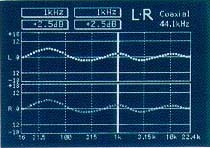 |
Equalizer mode
This is the standard display which can be used to call up, modify, and
store equalization curves.
|
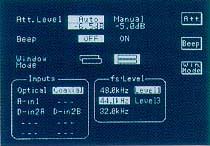 |
Environment setting mode
This screen serves to select input sources and make settings such as beep
tone on/off, display function, attenuator level etc. |
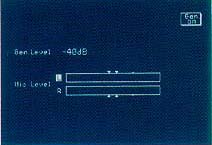 |
Analyzer mode
The sound field measurement and compensation process is initiated from
this screen. |
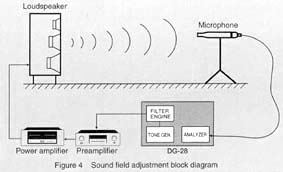
|
|
The DG-28 incorporates analyzer and sound field compensation functions.
Using a built-in test signal tone generator and a supplied microphone,
the acoustic properties of the listening room can be measured and corrected
automatically.
Built-In Digital Tone Generator and Analyzer
Adjusting the controls of an equalizer by ear has its limitations. In order
to perform precise compensation, a signal tone generator and a frequency
analyzer are required. The DG-28 already provides all of these elements.
Figure 4 shows the principle of sound field measurement and compensation
as performed by the DG-28 . For measurement, the tone generator output
is connected to the filter engine which in turn supplies the signal to
the preamplifier and power amplifier, to drive the loudspeakers. The reproduced
sound is picked up by the microphone placed at the listening position,
and the signal from the microphone is supplied to the frequency analyzer
in the DG-28 . This allows measuring the overall response of the reproduction
system in its normal state, with all components connected and working as
they would normally.
For the measurement, a so-called warble tone (a signal which fluctuates
over a very narrow frequency range) is used. By sweeping this signal over
the entire audio frequency range, precise acoustic measurements can be
made in a short time, without adverse influences from extraneous noise.
Because both the tone generator and the frequency analyzer are digital
circuits implemented by a DSP, highly sophisticated algorithms developed
by Accuphase can be used, assuring precise and stable operation as well
as exact reproducibility.
Automatic Compensation of Sound Field Characteristics
Because the DG-28 is a precision equalizer with 64 distinct frequency bands
per channel, adjusting the response curve entirely by hand would require
a considerable amount of time and expertise. While this is an option that
can be chosen if desired, the DG-28 also offers another way, namely automatic
adjustment using special algorithms developed by Accuphase. By following
the simple steps listed below, the sound field at the listening position
can be quickly and effectively optimized.
1. Activate analyzer mode
2. Adjust microphone input level
3. Set desired target response curve (preset or specified by user)
4. Activate automatic measurement and compensation
5. If desired, fine tune response manually
6. Use DG-28 in equalizer mode
The time required for the above process will vary somewhat, depending on
the speakers and the listening room conditions. A representative figure
is about five to six minutes per channel. For even higher precision, it
is possible to repeat the measurement as often as desired and average the
results. Figure 5 shows an example for automatic measurement and compensation
with "flat" target response. The peaks and dips caused by listening
room and speaker irregularities are evened out, resulting in a response
curve that is much more linear.
Manual Fine Tuning Possible
After automatic adjustment is completed, the user has the option to fine-tune
settings in each 1/6-octave band. It is also possible to perform the entire
measurement and adjustment process manually if desired.
Doubles as Sound Field Evaluation Tool
Another use for the DG-28 is as a tool in performing a sound field measurement
only, without providing any compensation. This comes in handy for example
to evaluate the characteristics of a loudspeaker or the listening room,
or to adjust a multi-amped system.
Up to 4 Sets of Measurement Data Can Be Stored
Four response curves can be stored and recalled at the touch of a button,
which is handy for example to apply different equalization to different
music genres, driving different sets of loudspeakers, making quick comparisons
of equalization effects, etc.
Supplied Microphone With Controlled Frequency Response
For sound field measurements, a high-quality microphone with wide and flat
frequency response is a must. The DG-28 therefore comes with the 1/4-inch
type back-electret condenser microphone AM-28. The ultra-thin diaphragm
of this microphone assures linear response over a wide range, allowing
accurate measurement and compensation.
|
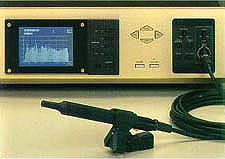
|
| Sound Field Measurement and Compensation Features~ Analyzer Mode ~ |
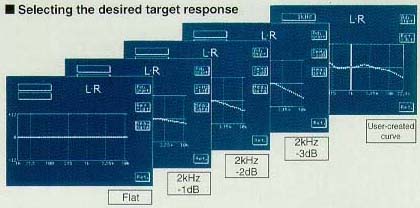
|
If adjustment is performed so as to achieve fully flat frequency response at the regular listening position, the audible result will be felt to be very bright. Normally, a gradually declining curve towards the upper frequency region is preferable.
Therefore the DG-28 incorporates three preset rolloff characteristics,
with 1 dB, 2 dB and 3 dB attenuation per octave, starting at 2 kHz. Alternatively,
the user can also specify any desired response curve. |
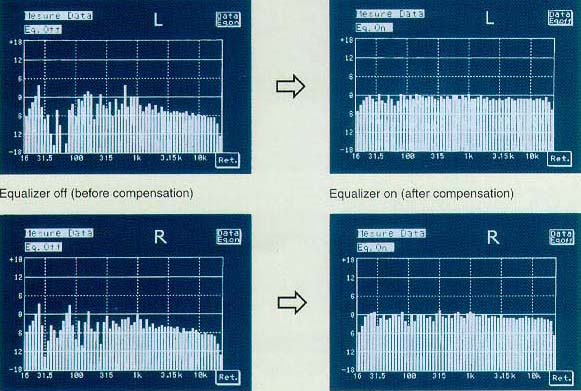 |
Optical and Coaxial Inputs and Outputs Allow Direct Digital Connection
to DC-300
The DG-28 is equipped with two sets of digital input/output connectors,
accommodating both fiber-optic and coaxial links. Because the Digital Preamplifier
DC-300 from Accuphase offers has EXT DSP connectors, the DG-28 can be directly
inserted in the signal path, remaining entirely within the digital domain.
Only immediately before the preamplifier outputs, the signal is converted
into analog form. Other digital sources such as a CD transport, DAT or
MD recorder or similar can also be connected directly to the digital inputs
of the DG-28. The output from the DG-28 may then be supplied to a high-quality
digital-to-analog converter. Option board slots on the rear of the DG-28
assure system flexibility, allowing the user to increase also the number
of digital input and outputs when required.
Analog Equipment Can Be Connected Via Option Boards
For connection to analog components, analog input and output boards can
be installed in the DG-28 . This allows connection for example in the tape
monitor loop (TAPE REC and PLAY) of a preamplifier or integrated amplifier.
Connection between a preamplifier and power amplifier is also possible.
Using analog line input boards, feeding the output of a CD player or tuner
into the DG-28 is another possibility. A line output board can then be
used to supply the equalized signal to the line input of a preamplifier.
To maintain the outstanding sound quality level that is the hallmark of
the DG-28, state-of-the-art converters mounted on the option boards turn
the signal into digital form for processing and back into analog form for
output.
Slots for Up to Four Boards
A wide array of input and output boards is available from Accuphase to
meet the needs of the professional and high-end user. All boards install
easily in four rear-panel slots conforming to the Accuphase Digital Bus
(ADB) interface standard.
|
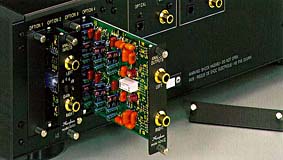
|
* Any board can be installed in any empty slot.
* All boards use the Accuphase Digital Bus (ADB) Interface.
The DG-28 is a fully digital voicing equalizer, but using option boards
inserted in dedicated slots on the rear of the unit, it can accept signals
also from analog equipment and output analog signals to such equipment.
This allows use in the same way as a conventional graphic equalizer. Various
option boards to expand the number of digital inputs and outputs are also
available.Analog Option Boards
 For analog input : Line Input Board AI-U1 (Unbalanced high-level input)Suitable for input of the analog signal from
a component such as a CD player, tuner, tape recorder or similar.* The
analog input signal is converted to a high-precision digital signal by
a 20-bit, 5-pole Delta-Sigma A/D converter with 64-times oversampling.
For analog input : Line Input Board AI-U1 (Unbalanced high-level input)Suitable for input of the analog signal from
a component such as a CD player, tuner, tape recorder or similar.* The
analog input signal is converted to a high-precision digital signal by
a 20-bit, 5-pole Delta-Sigma A/D converter with 64-times oversampling.
 For analog output : Line Output Board AO-U2 (Unbalanced high-level output)
For analog output : Line Output Board AO-U2 (Unbalanced high-level output)
* The signal from the DG-28 is converted to an analog signal by a high-precision MMB type D/A converter on the board.
* The board has a higher output voltage rating than the Line Output Board
.
* D/A converter 20 bit, 4 MMB principle
* Digital filter 20 bit, 8-times oversampling
* Max. output voltage 5.0 V
 For balanced analog input : Balanced Input Board AI-B1 (Balanced high-level input)
For balanced analog input : Balanced Input Board AI-B1 (Balanced high-level input)
* Suitable for the analog signal from the balanced output of components such as a CD player, tuner, tape recorder
or similar.
* The analog input signal is converted to a high-precision digital signal by a 20-bit, 5-pole Delta-Sigma A/D
converter with 64-times oversampling.
 For balanced analog output : Balanced Output Board AO-B2 (Balanced high-level output)
For balanced analog output : Balanced Output Board AO-B2 (Balanced high-level output)
* The signal from the DG-28 is converted to an analog signal by a high-precision MMB type D/A converter on the board.
* The board has a higher output voltage rating than the Balanced Output
Board AO-B1.
* D/A converter 20 bit, 4 MMB principle
* Digital filter 20 bit, 8-times oversampling
* Max. output voltage 5.0 V
 For analog input/output : Line Input/Output Board AIO-U1 (Unbalanced input and output)
For analog input/output : Line Input/Output Board AIO-U1 (Unbalanced input and output)
 For playback of analog records : Analog Disc Input Board AI-AD1
For playback of analog records : Analog Disc Input Board AI-AD1
(High-performance, high-gain phono equalizer board for use with an analog record player.)
Digital Option Boards
 For BNC coaxial input : BNC Coaxial Input Board DI-BNC1 (For coaxial cable (75 ohms) with BNC connector)
For BNC coaxial input : BNC Coaxial Input Board DI-BNC1 (For coaxial cable (75 ohms) with BNC connector)
 For HPC optical input : HPC Optical Input Board DI-ST1 (For connection of ST type HPC optical link)* HPC optical fiber cables
(HLG-10 etc.) are available from Accuphase. For HPC optical input : HPC Optical Input Board DI-ST1 (For connection of ST type HPC optical link)* HPC optical fiber cables
(HLG-10 etc.) are available from Accuphase.
 To add digital inputs/outputs : Digital Line Input/Output Board DIO-OC1 To add digital inputs/outputs : Digital Line Input/Output Board DIO-OC1
Provides coaxial and optical inputs and outputs for digital signals
 For professional standard input/output : AES/EBU Input/Output Board DIO-PRO1
For professional standard input/output : AES/EBU Input/Output Board DIO-PRO1
Provides a balanced XLR input and outputs for digital signals corresponding to professional AES/EBU specifications.
* HPC optical fiber cables (HLG-10 etc.) are available from Accuphase.
|
|
|
|
|
|
|
|